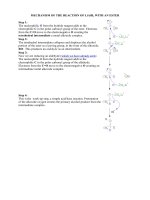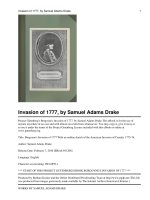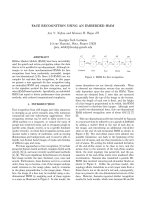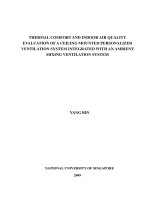AN1212 using USB keyboard with an embedded host
Bạn đang xem bản rút gọn của tài liệu. Xem và tải ngay bản đầy đủ của tài liệu tại đây (485.23 KB, 14 trang )
AN1212
Using USB Keyboard with an Embedded Host
Author:
Amardeep Gupta
Microchip Technology Inc.
as Ctrl, Shift, Alt and GUI keys make up the 8-bit modifier
byte in a standard keyboard report. Byte 1 of this report
is a constant. This byte is reserved for the use of the
Original Equipment Manufacturer (OEM).
INTRODUCTION
Table 2 describes the keyboard output report (1 byte).
Microcontroller applications can easily support USB
embedded host functionality with the introduction of
Microchip’s microcontrollers with the USB OTG
peripheral. Traditionally, personal computers have been
used as hosts in a USB network. Microchip’s USB OTG
product line can now replace the personal computer in
the system by implementing an embedded host.
TABLE 2:
Many embedded applications require control inputs from
external devices, such as keyboards, mice, joysticks,
Point-of-Sale (POS) barcode scanners and magnetic
code readers having HID Keyboard Emulation mode.
This application note demonstrates how to develop a
USB keyboard application that can run on the Explorer
16 demo board with a USB PICtail™ Plus daughter
board using a Microchip USB OTG microcontroller as the
embedded host.
USB Keyboard Overview
USB is now the preferred method to interface
peripherals with computers. The conventional PS2
keyboard has been replaced with a standard USB keyboard to interface with the computer (host). A standard
USB keyboard sends an 8-byte input report to the host.
Table 1 describes the keyboard input report (8 bytes).
TABLE 1:
USB KEYBOARD INPUT
REPORTS
Byte
Description
0
Modifier Keys
1
Reserved
2
Key Code 1
3
Key Code 2
4
Key Code 3
5
Key Code 4
6
Key Code 5
7
Key Code 6
For some keyboards that have a custom implementation
that does not match a standard keyboard implementation, a look-up table may be required in order to map the
key code returned to the desired usage ID. Keys, such
© 2008 Microchip Technology Inc.
Bit
USB KEYBOARD OUTPUT
REPORT
Description
0
Num Lock
1
Caps Lock
2
Scroll Lock
3
Compose
4
KANA
5 to 7
Constant
A standard keyboard has three LEDs to display Num
Lock, Caps Lock and Scroll Lock status. The LEDs are
absolute output items; the state of each LED must be
included in the output reports (0 = OFF, 1 = ON). In the
keyboard demo application, Num Lock and Caps Lock
LEDs have been implemented.
USB Keyboard with an Embedded Host
This application demo illustrates the Human Interface
Device (HID) host capability. A low-speed or full-speed
USB keyboard can be connected to the host MCU on
an Explorer 16 board through a USB PICtail™ Plus
daughter board. The demo schedules the HID transfers
and interprets the reports received from the keyboard.
Key codes are decoded to their respective ASCII
values and are displayed on the LCD display on the
Explorer 16 demo board.
Since the purpose of this application is to demonstrate
the capabilities of the HID host, not all the key codes
have been implemented. This demo helps the user to
understand the HID host capabilities. Users can
incorporate the necessary changes required for their
application. All of the alphabetic, numeric and special
characters have been implemented, as well as the Esc,
Shift, Caps Lock, Arrow and Spacebar keys.
Note:
Refer to the “Device Class Definition for
Human Interface Devices (HID)” for keyboard implementation details (see the
“References” section).
DS01212A-page 1
AN1212
Application Architecture
The keyboard application is actually a multi-layer stack
(see Figure 1) with different components of Microchip’s
USB embedded host support package contributing to
different layers.
Table 3 lists the source files used in this application and
which layer those files implement.
FIGURE 1:
APPLICATION
ARCHITECTURE
FIGURE 2:
DEFAULT DIRECTORY
STRUCTURE FOR USB
KEYBOARD HOST SUPPORT
Local Hard Drive (C:)
Microchip Solutions
+
Microchip
+
Common
+
Common Microchip
Source Files
Include
+
Application Layer (Keypad, Joystick...)
USB
+
USB Header Files
HID Interface Layer
Common Microchip
Header Files
HID Parser/Client Layer
+
USB Embedded Host Layer
USB
+
Documentation
+
Client Driver
Directories
USB Source Files
Getting Started with the USB Host Stack
This section describes the various steps involved in
getting started with the USB host stack.
The USB keyboard application is available as part of
Microchip’s complete USB embedded host support
package (see Appendix A: “Software Discussed in
this Application Note” for more details).
+
Help
Help Files
+
USB Host-HID-Keyboard
Project Files
USB Tools
+
+
USBConfig Tool
INSTALLING THE USB HOST STACK
To install all the required project files on a host PC:
1.
Download the installation file from the Microchip
web site:
/>
2.
Run the executable installer file.
By default, the project and stack files will be
installed in the directory structure displayed in
Figure 2.
DS01212A-page 2
USB EMBEDDED HOST LAYER
The USB embedded host layer provides basic USB
embedded host support. The interface to this layer is
provided automatically in the HID client driver. For more
information about this layer, refer to Microchip’s AN1140,
“USB Embedded Host Stack” and AN1141, “USB
Embedded Host Stack Programmers Guide”.
It is not necessary to be familiar with this layer’s
operation or configuration in order to use it with the
keyboard application.
© 2008 Microchip Technology Inc.
AN1212
HID CLIENT DRIVER/HID PARSER
HID INTERFACE LAYER
The next layer provides the client driver for the Human
Interface HID (Class) and HID parser. The HID client is
needed for interfacing to HID devices, like mice,
keyboards, joystick controls, etc. Refer to Microchip
Application Note AN1144, “USB Human Interface Device
Class on an Embedded Host” for more information about
the HID client driver.
The interface layer is provided to integrate the user
application with the HID client/HID parser. This layer
provides interface functions for the application to interact with the HID client/HID parser. HID client interface
functions can be used to exchange reports with devices
attached on the bus. HID parser interface functions can
be used to interpret the report descriptor and decode
the input report received from the device. Refer to
AN1144, “USB Human Interface Device Class on an
Embedded Host” for more information on the HID
parser.
Note:
Memory allocation for descriptor related
information is dynamic. Report descriptor
data structures consume less than
300 bytes per interface. The application
should reserve at least 1 Kbyte of heap
while using the HID host stack.
TABLE 3:
File Name
Description
usb_host.c
Provides USB embedded host support for all devices.
Does not provide class support.
usb_host.h
Header file with definitions required for USB embedded
hosts. Defines the interface to the USB embedded host
driver.
USB Embedded
Host Layer
usb.h, usb_ch9.h,
usb_common.h, usb_hal.h,
usb_hal_pic24.h
Other USB support header files.
usb_host_hid.c
Provides HID class support to a USB embedded host.
usb_host_hid.h
Header file with definitions for USB embedded hosts
supporting the HID class. Defines the interfaces to the HID
client driver.
usb_host_hid_parser.c
Provides a HID report descriptor parser and data
structures.
usb_host_hid_parser.h
Header file with interface functions to report descriptor
parser and definitions supporting the data structures.
usb_host_hid_appl_interface.c
HID Interface
For detailed information about the USB
embedded host HID interface APIs, refer
to the USB Embedded Host Library
documentation provided in the Help
directory.
FILES USED FOR KEYBOARD APPLICATION
Layer
HID Client
Driver/Parser
Note:
Provides Interface functions to access the HID
client/parser.
usb_host_hid_appl_interface.h Header file containing interface definitions used to access
the HID client/parser.
Application
uart2.c
Provides an interface to UART2 to provide RS-232 input
and output to the application.
uart2.h
Header file for the UART2 functions.
usb_config.c
Configures the USB stack for the application; generated
by the configuration tool.
usb_config.h
Configures the USB stack for the application; generated
by the configuration tool.
HardwareProfile.h
Contains system level constants for libraries to reference.
lcd_demo.c
Provides support functions for the LCD driver and display
routines.
lcd_demo.h
Header file containing interface definitions for the LCD.
keyboard_demo.c
© 2008 Microchip Technology Inc.
Main application code.
DS01212A-page 3
AN1212
Application Functionality
The USB keyboard application demo is intended to
demonstrate the features of the Microchip HID host.
The application can interface to a USB keyboard with
the Explorer 16 demo board using the USB PICtail Plus
daughter board. The user might have to modify the TPL
settings depending on the number of interfaces the
keyboard supports. The main features of the keyboard
demo are:
•
•
•
•
Parsed Data Collection Handler
Receive Input Reports
Transmit Output Reports
LCD Display Function
Parsed Data Collection Handler
An HID device must have at least one report descriptor.
Report descriptors are composed of pieces of information. Each piece of information is called an item. The
HID client driver incorporates an HID parser. The HID
class client driver contains a parser used to analyze
items found in the report descriptor. The parser extracts
information from the descriptor in a linear fashion. The
parser collects the state of each item known as it walks
through the descriptor and stores it in a structure in the
form of a table. Refer to Microchip’s AN1144, “USB
Human Interface Device (HID) Class on an Embedded
Host” for more information about the HID client driver.
The HID client driver generates an event,
EVENT_HID_RPT_DESC_PARSED, after a report
descriptor has been parsed without an error. The application must provide a callback function to collect the
parsed information stored in the data structures. The
configuration tool has a provision to enter the function’s
name. In this keyboard application demo, the
USB_HID_DataCollectionHandler() function collects the parsed information and stores it in the structure,
HID_DATA_DETAILS.
Table 4 lists the structures provided.
Receive Input Reports
The host application receives an 8-byte input report from
the device. Timer3 is used to trigger the send request for
the input report. Timer3 triggers the request depending
on the polling rate defined by the configuration
descriptor. The polling rate for the input report is stored
in the structure, USB_HID_DEVICE_RPT_INFO, and
accessed
using
the
interface
function,
USBHostHID_GetCurrentReportInfo().
DS01212A-page 4
The interface function, USBHostHID_ApiGetReport(),
is used to request the input report from the device. The raw
input report received from the device is stored in the
Appl_raw_report_buffer structure. It contains
information of all the keys pressed in that duration. The
raw
report
is
then
passed
to
the
USBHostHID_ApiImportData() interface function.
Then, the data is extracted and the application buffers
are populated.
The application then processes the data based on the key
pressed. Two shadow buffers, Appl_ShadowBuffer1
and Appl_ShadowBuffer2, are used to keep track of
the keys pressed in the previous two reports. Data from
the current buffer is copied into the shadow buffers after
processing the current report buffer and the data in the
current report buffer and raw report buffers are cleared.
Table 5 lists the input report buffers declared in the
application.
Transmit Output Reports
Common USB keyboards have LEDs to display Caps
Lock, Num Lock and Scroll Lock status. The LED status
is sent by the host application as an output report to the
device. The number of LEDs supported by the keyboard and the format of the report are described in the
report descriptor. As described in the previous section,
the application should collect the report format details
after the report descriptor has been parsed. Depending
on the key combinations pressed, the application can
decide the status of the LED indicator and store it in the
output report buffer.
The rate of sending output reports is not fixed; they are
aperiodic transfers. The user application can decide to
transmit the report whenever a change in the LED
status occurs.
Table 6 lists the output report buffer declared in the
application.
Note:
For detailed information about the USB
embedded host HID interface APIs, refer
to the USB Embedded Host Library
documentation provided in the Help
directory.
© 2008 Microchip Technology Inc.
AN1212
LCD Display Function
Upon power-up, the following banner displays on the
LCD display:
Device Detached
Upon connecting a keyboard, if the device is
enumerated without any errors, the following banner
displays on the LCD display:
The keyboard is now ready for use. When the first key
press is received, the application clears the banner and
starts displaying keys as they are pressed.
The input report received from the device consists of
the usage IDs of the keys pressed within that period. All
the alphabetic and special characters are converted to
their respective ASCII values. The characters are
displayed on the LCD on the Explorer 16 board.
Table 7 displays the action taken on the key codes
received from the device.
Explorer16 Board
USB HIDHost Demo
TABLE 4:
HID_DATA_DETAILS OBJECTS
Object
Description
Appl_ModifierKeysDetails
This structure stores the key details for the modifier keys (Ctrl,
Shift, Alt and GUI).
Appl_NormalKeysDetails
This structure stores the input key details for all the other keys.
Appl_LED_Indicator
This structure stores the LED indicator output report details.
TABLE 5:
INPUT REPORT BUFFER
Buffer
Description
Appl_raw_report_buffer
This buffer stores the report details and a pointer to the raw input
report data received from the device.
Appl_BufferNormalKeys
This buffer stores the pressed instance data for the rest of the
keys on the keyboard.
Appl_BufferModifierKeys
This buffer stores the pressed instance data for the modifier
keys (Ctrl, Shift, Alt and GUI) for the current report received from
the device.
TABLE 6:
TRANSMIT OUTPUT REPORT BUFFER
Buffer
Appl_led_report_buffer
© 2008 Microchip Technology Inc.
Description
This buffer stores the indicator status for the Caps Lock, Num
Lock and Scroll Lock LEDs.
DS01212A-page 5
AN1212
TABLE 7:
ACTION ON KEY CODES RECEIVED FROM THE DEVICE
Key
Pressed
Action
Characters
ON
All the letters and special characters are displayed on the LCD.
Shift
ON
If the Caps Lock is on, letters are displayed in lower case; otherwise, they
are displayed in upper case. Special characters are displayed instead of
numbers.
If the Caps Lock is off, letters are displayed in upper case; otherwise, they
are displayed in lower case. Numbers are displayed.
OFF
Esc
ON
LCD display is cleared.
Space
ON
Advances the cursor on the LCD by one space.
Back Space
ON
Character on the left of the cursor is deleted.
Caps Lock
ON
Letters are displayed in upper case. Output report with Caps Lock LED
status high is sent.
Letters are displayed in lower case. Output report with Caps Lock LED
status low is sent.
OFF
Num Lock
ON
OFF
Arrow Keys
DS01212A-page 6
ON
Output report with Num Lock LED status high is sent. Enables numeric keys
on the keypad.
Output report with Caps Lock LED status low is sent. Enables Arrow keys
on the keypad.
Moves the cursor on the LCD display.
© 2008 Microchip Technology Inc.
AN1212
THE USB CONFIGURATION TOOL
• TPL Entry 2
- Support via Class ID is selected
- Client Driver: HID
- Class: HID (0x03)
- SubClass: None (0x00)
- Protocol: None (0x00)
- Initial Configuration: 0
- Initialization Flags: 0
- HNP: Not Allowed
The USB keyboard application has already been
configured by using the graphic USB configuration tool,
USBConfig.exe, located in the installation directory,
\USB Tools\USBConfig Tool. The configuration
files (usb_config.c and usb_config.h) were
generated and stored in the .\USB Host - HID Keyboard project directory. The following configuration
options have been selected:
1.
2.
On the Main tab (Figure 3):
- Device Type: USB Embedded Host
- Ping-Pong Mode: All Endpoints
On the Host tab (Figure 4):
- Transfer Types: Interrupt only, with 50
NAKs allowed (control transfers are also
enabled with dialog text appearing in grey)
- Attach Debounce Interval: 250 ms
- Name of Application Event Handler:
USB_ApplicationEventHandler
Note 1: The Attach Debounce Interval is
increased from the USB specification of
100 ms to allow for slower devices.
2: To conserve program and data memory,
transfer events are not used.
3: The number of allowed NAKs depends on
the Idle rate of the device attached.
3.
At the TPL tab (Figure 5):
• TPL Entry 1
- Support via Class ID is selected
- Client Driver: HID
- Class: HID (0x03)
- SubClass: Boot (0x01)
- Protocol: Keyboard (0x01)
- Initial Configuration: 0
- Initialization Flags: 0
- HNP: Not Allowed
EXAMPLE 1:
Note:
4.
This demo application supports only
standard keyboard interfaces. If the user
keyboard supports multimedia functions,
then the TPL entries need to be changed
to support new interfaces.
On the HID tab (see Figure 6):
a. The HID Client used in Host mode is to be
selected.
b. Input reports can be of varied lengths. While
configuring, the host application needs to
inform the client of the maximum data field
size in bits. As illustrated in Example 1, for
this input report, the user must enter 14 as
the “Maximum Data Field Size”.
c. Under “Application Interface”, “Default
Interface” is selected. The “Parsed Data
Collection Handler” is provided by the
application.
Note:
If the host application is aware of the
input/output report format, then the parsed
data collection handler can be ignored and
the field can be disabled by deselecting
the check box.
DATA FIELDS FOR 4-BYTE INPUT REPORT
© 2008 Microchip Technology Inc.
DS01212A-page 7
AN1212
FIGURE 3:
USB CONFIGURATION TOOL, MAIN TAB
FIGURE 4:
USB CONFIGURATION TOOL, HOST TAB
DS01212A-page 8
© 2008 Microchip Technology Inc.
AN1212
FIGURE 5:
USB CONFIGURATION TOOL, TPL TAB
FIGURE 6:
USB CONFIGURATION TOOL, HID TAB
© 2008 Microchip Technology Inc.
DS01212A-page 9
AN1212
CONCLUSION
REFERENCES
Standard input devices, like keyboards, mice and
joysticks, intended to be used with a PC, can be easily
interfaced with an embedded system.
For more information on components of the Microchip
USB embedded host support package, the following
documents are available at the Microchip web site
(www.microchip.com/usb):
Using Microchip’s USB embedded host capability with
the HID client driver, embedded applications can
connect user interface devices to an embedded
system.
• Microchip’s AN1140, “USB Embedded Host
Stack” (DS01140)
• Microchip’s AN1141, “USB Embedded Host Stack
Programmer’s Guide” (DS01141)
• Microchip’s AN1144, “USB Human Interface
Device Class on an Embedded Host”
For more information on USB and embedded host
functionality, in general:
• USB Implementers Forum, “Universal Serial Bus
Revision 2.0 Specification”,
/>• USB Implementers Forum, “Device Class
Definition for Human Interface Devices (HID)”,
/>• USB Implementers Forum, “Requirements and
Recommendations for USB Products with
Embedded Hosts and/or Multiple Receptacles”,
/>
DS01212A-page 10
© 2008 Microchip Technology Inc.
AN1212
APPENDIX A:
SOFTWARE
DISCUSSED IN THIS
APPLICATION NOTE
The USB keyboard application is available for
download as part of Microchip’s USB Embedded Host
Library. This software library contains the source code
and support files required for all layers of the
application. Interested users may download the
USB Embedded Host Library from the Microchip
corporate web site, at www.microchip.com/usb.
© 2008 Microchip Technology Inc.
DS01212A-page 11
AN1212
NOTES:
DS01212A-page 12
© 2008 Microchip Technology Inc.
Note the following details of the code protection feature on Microchip devices:
•
Microchip products meet the specification contained in their particular Microchip Data Sheet.
•
Microchip believes that its family of products is one of the most secure families of its kind on the market today, when used in the
intended manner and under normal conditions.
•
There are dishonest and possibly illegal methods used to breach the code protection feature. All of these methods, to our
knowledge, require using the Microchip products in a manner outside the operating specifications contained in Microchip’s Data
Sheets. Most likely, the person doing so is engaged in theft of intellectual property.
•
Microchip is willing to work with the customer who is concerned about the integrity of their code.
•
Neither Microchip nor any other semiconductor manufacturer can guarantee the security of their code. Code protection does not
mean that we are guaranteeing the product as “unbreakable.”
Code protection is constantly evolving. We at Microchip are committed to continuously improving the code protection features of our
products. Attempts to break Microchip’s code protection feature may be a violation of the Digital Millennium Copyright Act. If such acts
allow unauthorized access to your software or other copyrighted work, you may have a right to sue for relief under that Act.
Information contained in this publication regarding device
applications and the like is provided only for your convenience
and may be superseded by updates. It is your responsibility to
ensure that your application meets with your specifications.
MICROCHIP MAKES NO REPRESENTATIONS OR
WARRANTIES OF ANY KIND WHETHER EXPRESS OR
IMPLIED, WRITTEN OR ORAL, STATUTORY OR
OTHERWISE, RELATED TO THE INFORMATION,
INCLUDING BUT NOT LIMITED TO ITS CONDITION,
QUALITY, PERFORMANCE, MERCHANTABILITY OR
FITNESS FOR PURPOSE. Microchip disclaims all liability
arising from this information and its use. Use of Microchip
devices in life support and/or safety applications is entirely at
the buyer’s risk, and the buyer agrees to defend, indemnify and
hold harmless Microchip from any and all damages, claims,
suits, or expenses resulting from such use. No licenses are
conveyed, implicitly or otherwise, under any Microchip
intellectual property rights.
Trademarks
The Microchip name and logo, the Microchip logo, Accuron,
dsPIC, KEELOQ, KEELOQ logo, MPLAB, PIC, PICmicro,
PICSTART, rfPIC and SmartShunt are registered trademarks
of Microchip Technology Incorporated in the U.S.A. and other
countries.
FilterLab, Linear Active Thermistor, MXDEV, MXLAB,
SEEVAL, SmartSensor and The Embedded Control Solutions
Company are registered trademarks of Microchip Technology
Incorporated in the U.S.A.
Analog-for-the-Digital Age, Application Maestro, CodeGuard,
dsPICDEM, dsPICDEM.net, dsPICworks, dsSPEAK, ECAN,
ECONOMONITOR, FanSense, In-Circuit Serial
Programming, ICSP, ICEPIC, Mindi, MiWi, MPASM, MPLAB
Certified logo, MPLIB, MPLINK, mTouch, PICkit, PICDEM,
PICDEM.net, PICtail, PIC32 logo, PowerCal, PowerInfo,
PowerMate, PowerTool, REAL ICE, rfLAB, Select Mode, Total
Endurance, UNI/O, WiperLock and ZENA are trademarks of
Microchip Technology Incorporated in the U.S.A. and other
countries.
SQTP is a service mark of Microchip Technology Incorporated
in the U.S.A.
All other trademarks mentioned herein are property of their
respective companies.
© 2008, Microchip Technology Incorporated, Printed in the
U.S.A., All Rights Reserved.
Printed on recycled paper.
Microchip received ISO/TS-16949:2002 certification for its worldwide
headquarters, design and wafer fabrication facilities in Chandler and
Tempe, Arizona; Gresham, Oregon and design centers in California
and India. The Company’s quality system processes and procedures
are for its PIC® MCUs and dsPIC® DSCs, KEELOQ® code hopping
devices, Serial EEPROMs, microperipherals, nonvolatile memory and
analog products. In addition, Microchip’s quality system for the design
and manufacture of development systems is ISO 9001:2000 certified.
© 2008 Microchip Technology Inc.
DS01212A-page 13
Worldwide Sales and Service
AMERICAS
ASIA/PACIFIC
ASIA/PACIFIC
EUROPE
Corporate Office
2355 West Chandler Blvd.
Chandler, AZ 85224-6199
Tel: 480-792-7200
Fax: 480-792-7277
Technical Support:
Web Address:
www.microchip.com
Asia Pacific Office
Suites 3707-14, 37th Floor
Tower 6, The Gateway
Harbour City, Kowloon
Hong Kong
Tel: 852-2401-1200
Fax: 852-2401-3431
India - Bangalore
Tel: 91-80-4182-8400
Fax: 91-80-4182-8422
India - New Delhi
Tel: 91-11-4160-8631
Fax: 91-11-4160-8632
Austria - Wels
Tel: 43-7242-2244-39
Fax: 43-7242-2244-393
Denmark - Copenhagen
Tel: 45-4450-2828
Fax: 45-4485-2829
India - Pune
Tel: 91-20-2566-1512
Fax: 91-20-2566-1513
France - Paris
Tel: 33-1-69-53-63-20
Fax: 33-1-69-30-90-79
Japan - Yokohama
Tel: 81-45-471- 6166
Fax: 81-45-471-6122
Germany - Munich
Tel: 49-89-627-144-0
Fax: 49-89-627-144-44
Atlanta
Duluth, GA
Tel: 678-957-9614
Fax: 678-957-1455
Boston
Westborough, MA
Tel: 774-760-0087
Fax: 774-760-0088
Chicago
Itasca, IL
Tel: 630-285-0071
Fax: 630-285-0075
Dallas
Addison, TX
Tel: 972-818-7423
Fax: 972-818-2924
Detroit
Farmington Hills, MI
Tel: 248-538-2250
Fax: 248-538-2260
Kokomo
Kokomo, IN
Tel: 765-864-8360
Fax: 765-864-8387
Los Angeles
Mission Viejo, CA
Tel: 949-462-9523
Fax: 949-462-9608
Santa Clara
Santa Clara, CA
Tel: 408-961-6444
Fax: 408-961-6445
Toronto
Mississauga, Ontario,
Canada
Tel: 905-673-0699
Fax: 905-673-6509
Australia - Sydney
Tel: 61-2-9868-6733
Fax: 61-2-9868-6755
China - Beijing
Tel: 86-10-8528-2100
Fax: 86-10-8528-2104
China - Chengdu
Tel: 86-28-8665-5511
Fax: 86-28-8665-7889
Korea - Daegu
Tel: 82-53-744-4301
Fax: 82-53-744-4302
China - Hong Kong SAR
Tel: 852-2401-1200
Fax: 852-2401-3431
Korea - Seoul
Tel: 82-2-554-7200
Fax: 82-2-558-5932 or
82-2-558-5934
China - Nanjing
Tel: 86-25-8473-2460
Fax: 86-25-8473-2470
Malaysia - Kuala Lumpur
Tel: 60-3-6201-9857
Fax: 60-3-6201-9859
China - Qingdao
Tel: 86-532-8502-7355
Fax: 86-532-8502-7205
Malaysia - Penang
Tel: 60-4-227-8870
Fax: 60-4-227-4068
China - Shanghai
Tel: 86-21-5407-5533
Fax: 86-21-5407-5066
Philippines - Manila
Tel: 63-2-634-9065
Fax: 63-2-634-9069
China - Shenyang
Tel: 86-24-2334-2829
Fax: 86-24-2334-2393
Singapore
Tel: 65-6334-8870
Fax: 65-6334-8850
China - Shenzhen
Tel: 86-755-8203-2660
Fax: 86-755-8203-1760
Taiwan - Hsin Chu
Tel: 886-3-572-9526
Fax: 886-3-572-6459
China - Wuhan
Tel: 86-27-5980-5300
Fax: 86-27-5980-5118
Taiwan - Kaohsiung
Tel: 886-7-536-4818
Fax: 886-7-536-4803
China - Xiamen
Tel: 86-592-2388138
Fax: 86-592-2388130
Taiwan - Taipei
Tel: 886-2-2500-6610
Fax: 886-2-2508-0102
China - Xian
Tel: 86-29-8833-7252
Fax: 86-29-8833-7256
Thailand - Bangkok
Tel: 66-2-694-1351
Fax: 66-2-694-1350
Italy - Milan
Tel: 39-0331-742611
Fax: 39-0331-466781
Netherlands - Drunen
Tel: 31-416-690399
Fax: 31-416-690340
Spain - Madrid
Tel: 34-91-708-08-90
Fax: 34-91-708-08-91
UK - Wokingham
Tel: 44-118-921-5869
Fax: 44-118-921-5820
China - Zhuhai
Tel: 86-756-3210040
Fax: 86-756-3210049
01/02/08
DS01212A-page 14
© 2008 Microchip Technology Inc.









